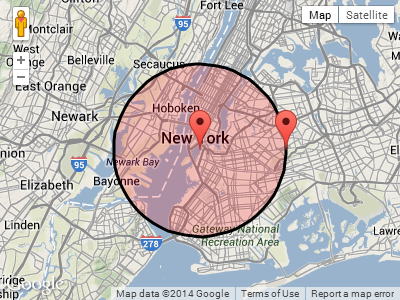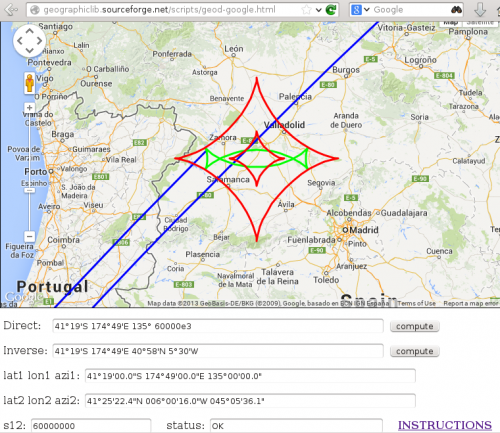Jak obliczyć latlng punktu pewnej odległości od innego?
Aby narysować okrąg na mapie mam środek (A) i promień (r) w metrach.
Oto schemat:
-----------
--/ \--
-/ \-
/ \
/ \
/ r \
| *-------------*
\ A / B
\ /
\ /
-\ /-
--\ /--
-----------
Jak obliczyć GLatLng w pozycji B? Zakładając, że r jest równoległy do równika.
Uzyskanie promienia, gdy podano A i B, jest trywialne przy użyciu GLatLng.metoda distanceFrom () - ale robienie tego na odwrót nie tak. Wygląda na to, że muszę zrobić trochę cięższej matematyki.
5 answers
Będziemy potrzebować metody, która zwraca punkt docelowy, gdy podane zostanie łożysko i odległość przebyta od punktu źródłowego. Na szczęście istnieje bardzo dobra implementacja JavaScript autorstwa Chrisa Veness w Oblicz odległość, łożysko i więcej między punktami szerokości / długości geograficznej .
Następujące zostały przystosowane do pracy z google.maps.LatLng klasa:
Number.prototype.toRad = function() {
return this * Math.PI / 180;
}
Number.prototype.toDeg = function() {
return this * 180 / Math.PI;
}
google.maps.LatLng.prototype.destinationPoint = function(brng, dist) {
dist = dist / 6371;
brng = brng.toRad();
var lat1 = this.lat().toRad(), lon1 = this.lng().toRad();
var lat2 = Math.asin(Math.sin(lat1) * Math.cos(dist) +
Math.cos(lat1) * Math.sin(dist) * Math.cos(brng));
var lon2 = lon1 + Math.atan2(Math.sin(brng) * Math.sin(dist) *
Math.cos(lat1),
Math.cos(dist) - Math.sin(lat1) *
Math.sin(lat2));
if (isNaN(lat2) || isNaN(lon2)) return null;
return new google.maps.LatLng(lat2.toDeg(), lon2.toDeg());
}
Można po prostu użyć go w następujący sposób:
var pointA = new google.maps.LatLng(25.48, -71.26);
var radiusInKm = 10;
var pointB = pointA.destinationPoint(90, radiusInKm);
Oto kompletny przykład użycia Google Maps API v3 :
<!DOCTYPE html>
<html>
<head>
<meta http-equiv="content-type" content="text/html; charset=UTF-8"/>
<title>Google Maps Geometry</title>
<script src="http://maps.google.com/maps/api/js?sensor=false"
type="text/javascript"></script>
</head>
<body>
<div id="map" style="width: 400px; height: 300px"></div>
<script type="text/javascript">
Number.prototype.toRad = function() {
return this * Math.PI / 180;
}
Number.prototype.toDeg = function() {
return this * 180 / Math.PI;
}
google.maps.LatLng.prototype.destinationPoint = function(brng, dist) {
dist = dist / 6371;
brng = brng.toRad();
var lat1 = this.lat().toRad(), lon1 = this.lng().toRad();
var lat2 = Math.asin(Math.sin(lat1) * Math.cos(dist) +
Math.cos(lat1) * Math.sin(dist) * Math.cos(brng));
var lon2 = lon1 + Math.atan2(Math.sin(brng) * Math.sin(dist) *
Math.cos(lat1),
Math.cos(dist) - Math.sin(lat1) *
Math.sin(lat2));
if (isNaN(lat2) || isNaN(lon2)) return null;
return new google.maps.LatLng(lat2.toDeg(), lon2.toDeg());
}
var pointA = new google.maps.LatLng(40.70, -74.00); // Circle center
var radius = 10; // 10km
var mapOpt = {
mapTypeId: google.maps.MapTypeId.TERRAIN,
center: pointA,
zoom: 10
};
var map = new google.maps.Map(document.getElementById("map"), mapOpt);
// Draw the circle
new google.maps.Circle({
center: pointA,
radius: radius * 1000, // Convert to meters
fillColor: '#FF0000',
fillOpacity: 0.2,
map: map
});
// Show marker at circle center
new google.maps.Marker({
position: pointA,
map: map
});
// Show marker at destination point
new google.maps.Marker({
position: pointA.destinationPoint(90, radius),
map: map
});
</script>
</body>
</html>
Zrzut ekranu:

UPDATE:
W odpowiedzi nakomentarz Pawła poniżej, tak się dzieje, gdy koło owija się wokół jednego z biegunów.
Plotowanie pointA w pobliżu bieguna północnego, o promieniu 1000 km:
var pointA = new google.maps.LatLng(85, 0); // Close to north pole
var radius = 1000; // 1000km
Zrzut ekranu dla pointA.destinationPoint(90, radius):

Warning: date(): Invalid date.timezone value 'Europe/Kyiv', we selected the timezone 'UTC' for now. in /var/www/agent_stack/data/www/doraprojects.net/template/agent.layouts/content.php on line 54
2017-05-23 11:47:27
Jeśli szukasz odległości między 2 punktami lat / LNG na powierzchni ziemi, możesz znaleźć javascript tutaj:
Http://www.movable-type.co.uk/scripts/latlong-vincenty.html
Jest to ta sama formuła używana w android API na android.location.Location::distanceTo
Możesz łatwo przekonwertować kod z javascript na Javę.
Jeśli chcesz obliczyć punkt docelowy biorąc pod uwagę punkt początkowy, łożysko i odległość, więc potrzebujesz tego. "metoda": {]}
Http://www.movable-type.co.uk/scripts/latlong-vincenty-direct.html
Oto wzory w Javie:
public class LatLngUtils {
/**
* @param lat1
* Initial latitude
* @param lon1
* Initial longitude
* @param lat2
* destination latitude
* @param lon2
* destination longitude
* @param results
* To be populated with the distance, initial bearing and final
* bearing
*/
public static void computeDistanceAndBearing(double lat1, double lon1,
double lat2, double lon2, double results[]) {
// Based on http://www.ngs.noaa.gov/PUBS_LIB/inverse.pdf
// using the "Inverse Formula" (section 4)
int MAXITERS = 20;
// Convert lat/long to radians
lat1 *= Math.PI / 180.0;
lat2 *= Math.PI / 180.0;
lon1 *= Math.PI / 180.0;
lon2 *= Math.PI / 180.0;
double a = 6378137.0; // WGS84 major axis
double b = 6356752.3142; // WGS84 semi-major axis
double f = (a - b) / a;
double aSqMinusBSqOverBSq = (a * a - b * b) / (b * b);
double L = lon2 - lon1;
double A = 0.0;
double U1 = Math.atan((1.0 - f) * Math.tan(lat1));
double U2 = Math.atan((1.0 - f) * Math.tan(lat2));
double cosU1 = Math.cos(U1);
double cosU2 = Math.cos(U2);
double sinU1 = Math.sin(U1);
double sinU2 = Math.sin(U2);
double cosU1cosU2 = cosU1 * cosU2;
double sinU1sinU2 = sinU1 * sinU2;
double sigma = 0.0;
double deltaSigma = 0.0;
double cosSqAlpha = 0.0;
double cos2SM = 0.0;
double cosSigma = 0.0;
double sinSigma = 0.0;
double cosLambda = 0.0;
double sinLambda = 0.0;
double lambda = L; // initial guess
for (int iter = 0; iter < MAXITERS; iter++) {
double lambdaOrig = lambda;
cosLambda = Math.cos(lambda);
sinLambda = Math.sin(lambda);
double t1 = cosU2 * sinLambda;
double t2 = cosU1 * sinU2 - sinU1 * cosU2 * cosLambda;
double sinSqSigma = t1 * t1 + t2 * t2; // (14)
sinSigma = Math.sqrt(sinSqSigma);
cosSigma = sinU1sinU2 + cosU1cosU2 * cosLambda; // (15)
sigma = Math.atan2(sinSigma, cosSigma); // (16)
double sinAlpha = (sinSigma == 0) ? 0.0 : cosU1cosU2 * sinLambda
/ sinSigma; // (17)
cosSqAlpha = 1.0 - sinAlpha * sinAlpha;
cos2SM = (cosSqAlpha == 0) ? 0.0 : cosSigma - 2.0 * sinU1sinU2
/ cosSqAlpha; // (18)
double uSquared = cosSqAlpha * aSqMinusBSqOverBSq; // defn
A = 1 + (uSquared / 16384.0) * // (3)
(4096.0 + uSquared * (-768 + uSquared * (320.0 - 175.0 * uSquared)));
double B = (uSquared / 1024.0) * // (4)
(256.0 + uSquared * (-128.0 + uSquared * (74.0 - 47.0 * uSquared)));
double C = (f / 16.0) * cosSqAlpha * (4.0 + f * (4.0 - 3.0 * cosSqAlpha)); // (10)
double cos2SMSq = cos2SM * cos2SM;
deltaSigma = B
* sinSigma
* // (6)
(cos2SM + (B / 4.0)
* (cosSigma * (-1.0 + 2.0 * cos2SMSq) - (B / 6.0) * cos2SM
* (-3.0 + 4.0 * sinSigma * sinSigma)
* (-3.0 + 4.0 * cos2SMSq)));
lambda = L
+ (1.0 - C)
* f
* sinAlpha
* (sigma + C * sinSigma
* (cos2SM + C * cosSigma * (-1.0 + 2.0 * cos2SM * cos2SM))); // (11)
double delta = (lambda - lambdaOrig) / lambda;
if (Math.abs(delta) < 1.0e-12) {
break;
}
}
double distance = (b * A * (sigma - deltaSigma));
results[0] = distance;
if (results.length > 1) {
double initialBearing = Math.atan2(cosU2 * sinLambda, cosU1 * sinU2
- sinU1 * cosU2 * cosLambda);
initialBearing *= 180.0 / Math.PI;
results[1] = initialBearing;
if (results.length > 2) {
double finalBearing = Math.atan2(cosU1 * sinLambda, -sinU1 * cosU2
+ cosU1 * sinU2 * cosLambda);
finalBearing *= 180.0 / Math.PI;
results[2] = finalBearing;
}
}
}
/*
* Vincenty Direct Solution of Geodesics on the Ellipsoid (c) Chris Veness
* 2005-2012
*
* from: Vincenty direct formula - T Vincenty, "Direct and Inverse Solutions
* of Geodesics on the Ellipsoid with application of nested equations", Survey
* Review, vol XXII no 176, 1975 http://www.ngs.noaa.gov/PUBS_LIB/inverse.pdf
*/
/**
* Calculates destination point and final bearing given given start point,
* bearing & distance, using Vincenty inverse formula for ellipsoids
*
* @param lat1
* start point latitude
* @param lon1
* start point longitude
* @param brng
* initial bearing in decimal degrees
* @param dist
* distance along bearing in metres
* @returns an array of the desination point coordinates and the final bearing
*/
public static void computeDestinationAndBearing(double lat1, double lon1,
double brng, double dist, double results[]) {
double a = 6378137, b = 6356752.3142, f = 1 / 298.257223563; // WGS-84
// ellipsiod
double s = dist;
double alpha1 = toRad(brng);
double sinAlpha1 = Math.sin(alpha1);
double cosAlpha1 = Math.cos(alpha1);
double tanU1 = (1 - f) * Math.tan(toRad(lat1));
double cosU1 = 1 / Math.sqrt((1 + tanU1 * tanU1)), sinU1 = tanU1 * cosU1;
double sigma1 = Math.atan2(tanU1, cosAlpha1);
double sinAlpha = cosU1 * sinAlpha1;
double cosSqAlpha = 1 - sinAlpha * sinAlpha;
double uSq = cosSqAlpha * (a * a - b * b) / (b * b);
double A = 1 + uSq / 16384
* (4096 + uSq * (-768 + uSq * (320 - 175 * uSq)));
double B = uSq / 1024 * (256 + uSq * (-128 + uSq * (74 - 47 * uSq)));
double sinSigma = 0, cosSigma = 0, deltaSigma = 0, cos2SigmaM = 0;
double sigma = s / (b * A), sigmaP = 2 * Math.PI;
while (Math.abs(sigma - sigmaP) > 1e-12) {
cos2SigmaM = Math.cos(2 * sigma1 + sigma);
sinSigma = Math.sin(sigma);
cosSigma = Math.cos(sigma);
deltaSigma = B
* sinSigma
* (cos2SigmaM + B
/ 4
* (cosSigma * (-1 + 2 * cos2SigmaM * cos2SigmaM) - B / 6
* cos2SigmaM * (-3 + 4 * sinSigma * sinSigma)
* (-3 + 4 * cos2SigmaM * cos2SigmaM)));
sigmaP = sigma;
sigma = s / (b * A) + deltaSigma;
}
double tmp = sinU1 * sinSigma - cosU1 * cosSigma * cosAlpha1;
double lat2 = Math.atan2(sinU1 * cosSigma + cosU1 * sinSigma * cosAlpha1,
(1 - f) * Math.sqrt(sinAlpha * sinAlpha + tmp * tmp));
double lambda = Math.atan2(sinSigma * sinAlpha1, cosU1 * cosSigma - sinU1
* sinSigma * cosAlpha1);
double C = f / 16 * cosSqAlpha * (4 + f * (4 - 3 * cosSqAlpha));
double L = lambda
- (1 - C)
* f
* sinAlpha
* (sigma + C * sinSigma
* (cos2SigmaM + C * cosSigma * (-1 + 2 * cos2SigmaM * cos2SigmaM)));
double lon2 = (toRad(lon1) + L + 3 * Math.PI) % (2 * Math.PI) - Math.PI; // normalise
// to
// -180...+180
double revAz = Math.atan2(sinAlpha, -tmp); // final bearing, if required
results[0] = toDegrees(lat2);
results[1] = toDegrees(lon2);
results[2] = toDegrees(revAz);
}
private static double toRad(double angle) {
return angle * Math.PI / 180;
}
private static double toDegrees(double radians) {
return radians * 180 / Math.PI;
}
}
Warning: date(): Invalid date.timezone value 'Europe/Kyiv', we selected the timezone 'UTC' for now. in /var/www/agent_stack/data/www/doraprojects.net/template/agent.layouts/content.php on line 54
2012-12-13 19:29:16
Odpowiedź na to pytanie i więcej można znaleźć tutaj: http://www.edwilliams.org/avform.htm
Warning: date(): Invalid date.timezone value 'Europe/Kyiv', we selected the timezone 'UTC' for now. in /var/www/agent_stack/data/www/doraprojects.net/template/agent.layouts/content.php on line 54
2018-01-27 22:51:39
Javascript dla wielu obliczeń geodezyjnych (problemy bezpośrednie i odwrotne, obliczenia powierzchni itp.). jest dostępny pod adresem
Http://geographiclib.sourceforge.net/scripts/geographiclib.js
Przykładowe użycie jest pokazane w
Http://geographiclib.sourceforge.net/scripts/geod-calc.html
Interfejs do google maps jest dostępny pod adresem
Http://geographiclib.sourceforge.net/scripts/geod-google.html
Obejmuje to geodezyjne (niebieski), geodezyjne koło (Zielony) i geodezyjne koperta (czerwony).

Warning: date(): Invalid date.timezone value 'Europe/Kyiv', we selected the timezone 'UTC' for now. in /var/www/agent_stack/data/www/doraprojects.net/template/agent.layouts/content.php on line 54
2017-05-18 17:55:48
Aby obliczyć lat, Długi punkt na danym łożysku i odległość od innego można użyć implementacji JavaScript googles:
var pointA = new google.maps.LatLng(25.48, -71.26);
var distance = 10; // 10 metres
var bearing 90; // 90 degrees
var pointB = google.maps.geometry.spherical.computeOffset(pointA, distance, bearing);
Zobacz https://developers.google.com/maps/documentation/javascript/reference#spherical Do dokumentacji
Warning: date(): Invalid date.timezone value 'Europe/Kyiv', we selected the timezone 'UTC' for now. in /var/www/agent_stack/data/www/doraprojects.net/template/agent.layouts/content.php on line 54
2017-09-07 11:02:49